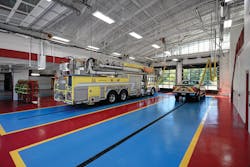Have you ever wondered how other cities, towns, counties and fire departments end up with new facilities while you still languish in an old, too-small, operationally incorrect facility? After paying a visit to new firehouses, speaking with their chiefs, evaluating their operations and response, do you start to see a pattern?
1. Follow the success of others
For those facilities that are designed to the latest standards and codes, and incorporate current trends, such as protection from cross-contamination, gender equity meeting ADA (Americans with Disabilities Act of 1990) compliance, do you wonder why the very best of these facilities share so many similarities? The answers to your questions and observations should be yes, we do see the common thread. As such, we would like to embark on the same path and employ the same strategies for success that others have used.
2. Get qualified help
Starting a fire station design and construction process can be intimidating and may be the only capital building project a department ever organizes. One of the first things to remember is don’t try to do it alone. Get qualified help. There are many excellent firehouse architects across the country who specialize in emergency response design. Hopefully, one of them will become an early team member and bring with them experienced consultants that will help you through the process of feasibility, design, site selection, approvals, budgeting, bidding and construction. There may be many other steps along the way, but a qualified architect will help you figure out which steps you may or may not need to take and why.
Envision this scenario that took place several years ago: A new firehouse opened to much fanfare in a community much like yours. The apparatus paraded from the old station to the new. Picture their embarrassment and chagrin when they saw that the ladder truck didn’t fit properly in the bays. One can only imagine that their design professional was not familiar with fire station design requirements and vehicle clearances. Had the designer known about FEMA FA-168, “Safety and Health Considerations for the Design of Fire and Emergency Medical Services Stations,” these standards would have alerted them to the recommended clearances around apparatus.
3. Understand the cost
Next, you must acknowledge that buildings are expensive. Firehouse Magazine, in its most recent Station Design Awards issue (November 2018), published figures that indicated construction costs for the fire stations completed in 2018 that ranged in cost from $4–$9 million. How can new stations be so expensive? A properly designed station isn’t just a garage; it’s a working facility that must perform 24/7/365. It’s a place to train, a place to live, a place to work—and it gets used hard. Modern firehouses must be flexible well into the future to accommodate changing response and an ever-changing mission. They should utilize sustainable materials and systems, should be resilient where necessary and be built by bonded, insured commercial contractors.
All building projects are subject to the effects of escalation, a phenomenon that causes projects to become more expensive with each passing year. The graph shows escalation for the last 50 years. The longer you wait, the more escalation can eat away at your current budget. Keep in mind that the 2018-completed fire stations mentioned above were actually bid in 2017 or late 2016. The over 5 percent annual escalation since that time would mean those VERY SAME stations being bid today (an average of 2 years later) would cost at least $4.4–$9.9 million. And if construction were to start next year, then $5.1–$10.4 million.
4. Get your fiscal house in order
To facilitate moving your project along the right path, one of the first things you can verify is that your fiscal house is in order. Whatever form of financing you will utilize—bonds, municipal capital improvement budgets, loans or even potential capital grants (difficult and rare)—make sure your debt limit is low and your credit rating is high. Let your community see that the fire department is fiscally responsible with taxpayer funds. Fiscal responsibility will go a long way in demonstrating to your public that your quest for a new facility makes economic sense and is grounded in reality.
5. Set a realistic budget
One of the most effective ways to show that you are fiscally responsible is to set a realistic budget. Note that this may not be the lowest budget possible, but rather the budget that reflects your specific needs, operations, growth trajectory, site constraints and vision. This is one of the most crucial steps you will take, and your qualified design professional will be invaluable to help with the many steps and actions needed to set a responsible budget.
Be careful at this critical juncture, as your budget consists of two major components. The largest of the two components is commonly called “hard costs.” These are “bricks and sticks” and the associated labor and overhead to erect them, also known as construction costs. The second component of your budget is “soft costs,” which consists of generally everything else in the project. This can include, land acquisition, off-site costs, survey, geotechnical report, professional fees, specialty equipment, furniture/fixtures/equipment (FF&E), security, communications, project contingencies, etc. The combination of hard and soft costs will determine your total project budget.
Note: Many people will start their inquiries into the process looking for a cost per square foot for a fire station. Per-square-foot costing is a valid method of very early budgeting but should be undertaken by an experienced professional, as it is one of the most misunderstood forms of budgeting. Why? To achieve a valid, meaningful cost per square foot for your project, an architect will weigh a large number of variables specific to your set of conditions. An entire article could probably be written just on this one concept, but here are just a few of the variables that affect per-square-foot costs:
- Site, its topography, soil types and natural features
- The project’s locale
- Available utilities
- Building size and number of stories
- Types of materials
- Infrastructure and systems
- Sustainability goals and possible resiliency needs
- Time of year
- Local regulations and codes
- Project schedule
- Operational needs
- Method of bidding and construction
- Current bidding environment
- Outside threats such as tariffs and a host of other factors
For example, if a neighboring community’s firehouse cost $1.00/square foot and your architect is determining that yours will be approximately $1.20/square foot (or 20 percent higher), there are generally valid reasons for such an increase. In addition to a differing set of variables, escalation comes into play due to the time difference between projects.
6. Start funding now
Whatever form of financing you use, start saving now, set realistic future budgets, devise capital plans over time, develop proformas or spreadsheets, and account for escalation on construction and inflation on some soft costs. Starting a funding stream and expectation for spending dollars over time will help ease the big spending burden later. The largest expenditure of funds is almost always construction. However, construction is the last major spending step in the process, so there’s often time to prepare.
7. Explore renovation or addition(s)
Your design professional can generate feasibility studies to perform a physical building assessment to determine what amount of life and usability your existing station has. Can the station handle the rigors of selective demolition needed for addition(s) and/or infrastructure renovations? For example, if the mechanical system is outdated, inefficient and doesn’t have adequate service, can it be cost-effectively removed and replaced? Is there enough land on your site in the right place to accommodate an addition? Can response aprons, parking and drives be made to work for an addition? These are just a few of the many questions and scenarios a feasibility study can answer.
8. Make it a campaign
To get the public, politicians, community leaders and your own membership on board, structure your request for a station and funding as a campaign. There have been many informative presentations at past Station Design Conferences about raising awareness, building community support and educating the voters about your project. These talks stress the idea of educating voters about the necessity for a station. Issues such as how the budget was developed, why modern firehouses are complicated facilities and the need for health, safety and well-being of the responders are all topics that the public should understand. There are numerous ways to engage the public. My particular method of choice is to educate. While an informed voter may be a no vote even after understanding the project, chances are quite good that this no vote won’t spread false rumors, inflate numbers or invent facts. The informed yes voters will generally spread the good word and share what they have learned.
9. Remember trends, flexibility, sustainability and resiliency
For a viable firehouse now and into the foreseeable future, include current trends, future flexibility, sustainability and resiliency in the design and budget. These are all concepts your qualified architect should be familiar with and incorporate in the facility. For example, the design can arrange and treat spaces to help protect responders from cross-contamination and the scourge of cancer. A facility can be located on the site to minimize response time while providing the opportunity for future expansion. Design for gender equity, ADA compatibility, firefighter safety, integrated training, operational ease, security, public interface and well-being within the facility. Options for sustainability, energy efficiency, zero-carbon footprint and resiliency against climate effects fall within the designer’s control. Always remember that your choices come with spatial needs, specialized infrastructure, specific systems and cost.
10. Don’t use give
Every successful project has its setbacks. Often the differentiator between successful projects and failed ones is the tenacity of those involved to adapt and overcome. While there is no secret formula, employing these strategies for success will help you achieve your goals and vision. Design and construction are a complex, expensive and time-consuming process. When you bring a qualified professional team on board early in the process, you have a partner who can assist you in executing these strategies and thereby increase the probability of overall project success.
About the Author

Dennis A. Ross
Dennis Ross, AIA, is a Technical Advisor and past Emergency Services Market Director at H2M architects + engineers. Previously, he was a founder and co-owner of a nationally recognized, award-winning firm exclusively dedicated to the design of emergency response facilities across North America. He has over 40 years of focused experience in construction and development, which allows him to assess projects from multiple points of view.
He is NCARB certified; a member of the American Institute of Architects, National Fire Protection Association (NFPA), and the International Code Council; licensed in 14 states; and an honorary member of the Kingston Fire Department. His expertise in public forums, project management, land use, budgeting, construction and focus on solutions to difficult problems has enabled him to knowledgeably write and speak on a variety of emergency services station design issues. Dennis has authored many articles and presented at even more conferences. In 2001, he received the Business Council of New York State’s and National Federation of Independent Business’ annual award for “New York State Small Business Advocate of the Year.”
Dennis is currently serving on the NFPA Technical Committee on “Emergency Responders Occupational Health,” which is tasked with developing a new Standard for Contamination Control, NFPA 1585. Dennis led the task group for Chapter 5, Emergency Services Organization Facilities. In 2022, he was appointed to the NFPA - Architects, Engineers, Building Officials (AEBO) commitee as an Executive Board Member.
